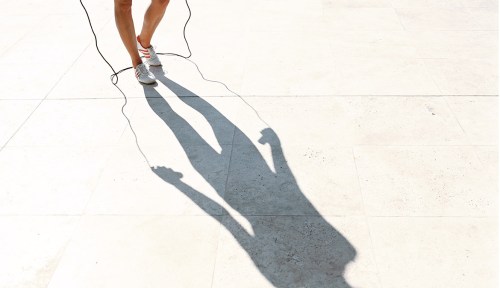The ‘Shadow Rule’ Can Clue You in on Exactly How Much Sun Damage You’re Actually Getting
As Earth rotates on its axis, the angle at which sunlight hits us changes. Use the shadow rule to know how strong current UV rays are.

As the Earth rotates on its axis—which, as you may remember from elementary school science, is what makes the sun appear to rise and set—the angle at which sunlight hits us changes. This shifting angle impacts the strength of the sun’s ultra-violet radiation, which is important to pay attention to any time you’re spending time outside. One of the easiest ways to do that is with the “shadow rule,” which will clue you in on the intensity of these UV rays at any given time during the day.
Experts in This Article
board-certified dermatologist
You’ve probably noticed that your shadow is shorter at some points during the day than others, and this can tell you a lot about the status of the sun. “If your shadow is shorter than you are, UV exposure is high,” says Andrea Suarez, MD, FAAD, a board-certified dermatologist based in Houston in a TikTok. “If your shadow is taller than you are, UV is less intense.”
The stronger the UV rays, the more likely you are to experience sun damage. These short shadows are most likely to happen when the sun is at its peak, explains Ivy Lee, MD, a board-certified dermatologist in Pasadena, California. “Be sure to seek shade and avoid the peak hours of sunlight from 10 a.m. to 4 p.m.,” says Dr. Lee.
This Parisian Skincare Brand Is Launching in the United States for the First Time—Here’s What a Derm Wants You to Know

We’re Calling It: Cleansing Balms Are the Face Wash of the Future—Here Are 3 to Add to Your Cart

This Is the One Product That Scarlett Johansson Always Keeps in Her Purse and on Her Bedside Table

If you are out during these times, make sure you’re diligent about applying the right amount of broad-spectrum sunscreen every two hours. And if you often have to spend long stretches outside during this window, consider investing in sun-protective UPF clothing. Remember that even if you don’t get a sunburn, you can still experience sun damage.
“There’s no such thing as a safe tan,” Dr. Lee previously told Well+Good. “Any time we are getting exposed to ultraviolet rays from being outdoors, we’re accumulating DNA damage in our skin cells—whether you’re laying out on the beach or running errands and picking up a little bit of sun exposure there. The DNA damage from all that sun exposure is cumulative, meaning that it builds up over time, and it’s what leads to the signs of premature aging that we see with wrinkles, dark spots, and leathery skin. It’s also what leads to skin cancer.”
How to apply sunscreen the right way:
Oh hi! You look like someone who loves free workouts, discounts for cutting-edge wellness brands, and exclusive Well+Good content. Sign up for Well+, our online community of wellness insiders, and unlock your rewards instantly.
Sign Up for Our Daily Newsletter
Get all the latest in wellness, trends, food, fitness, beauty, and more delivered right to your inbox.
Got it, you've been added to our email list.







